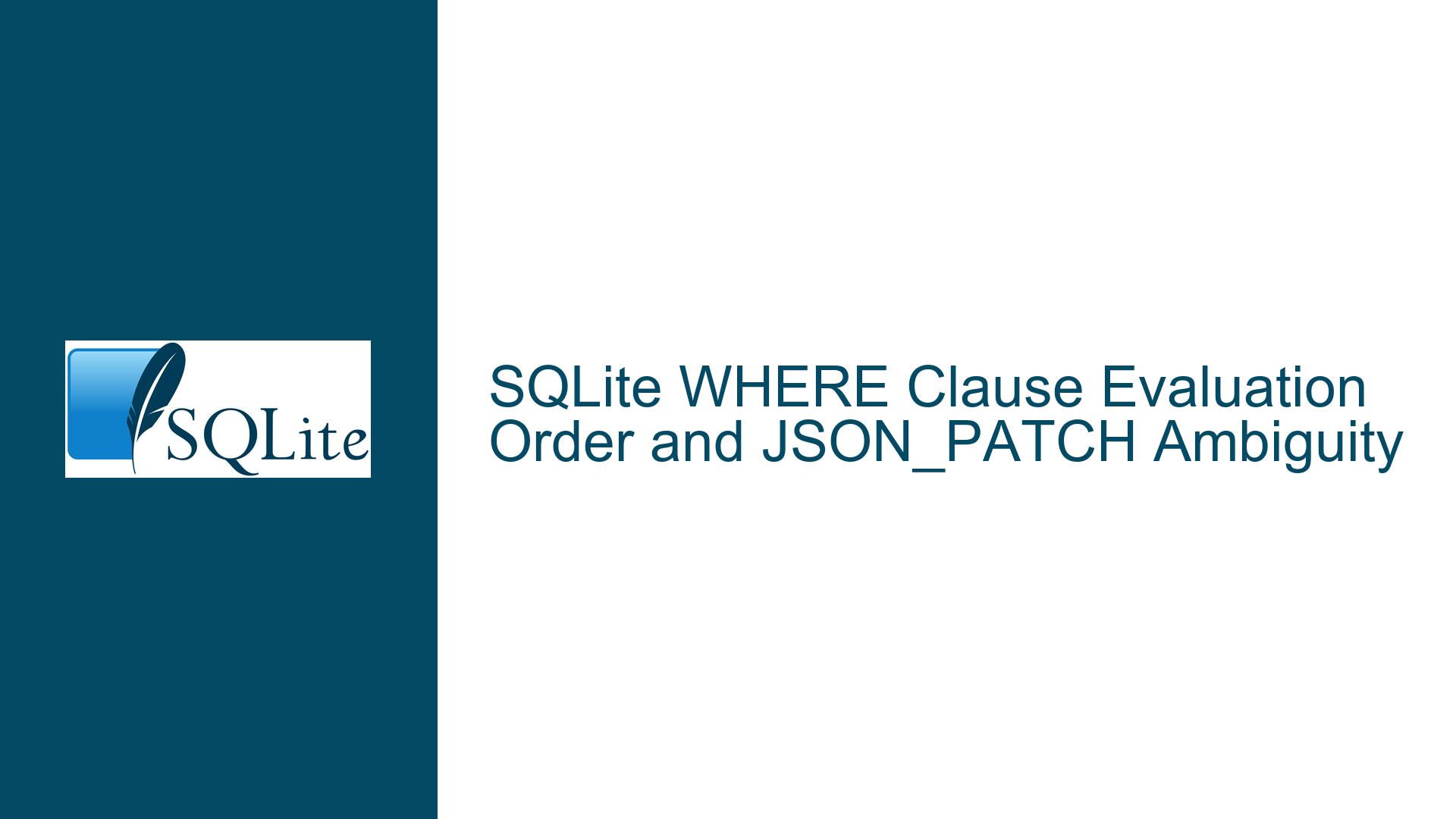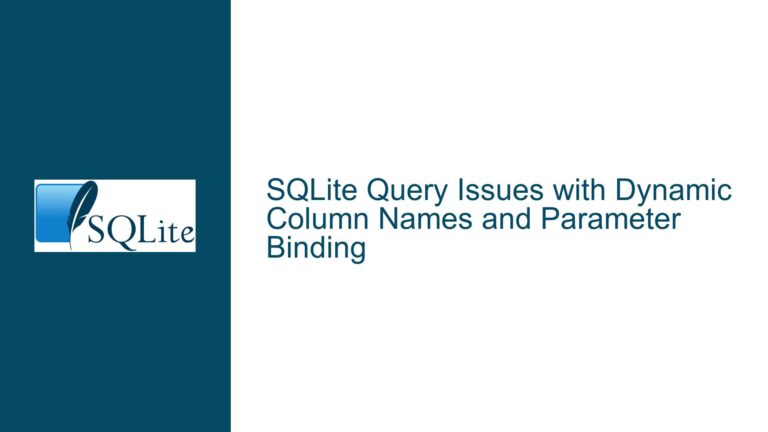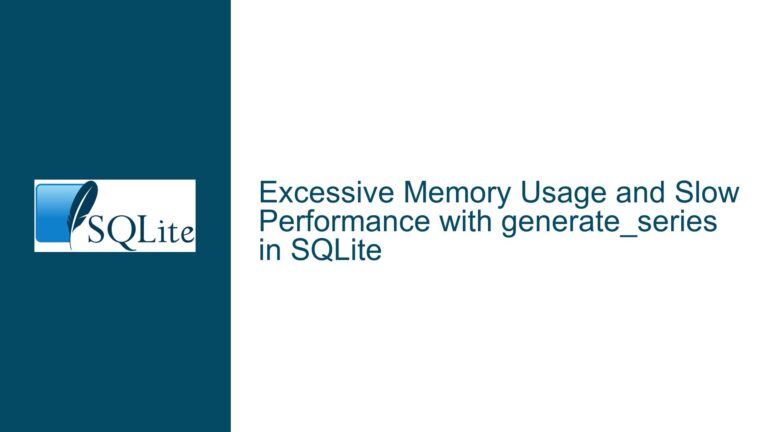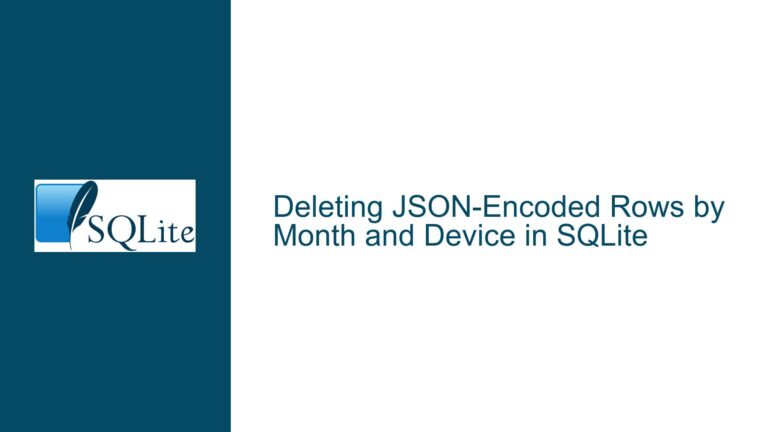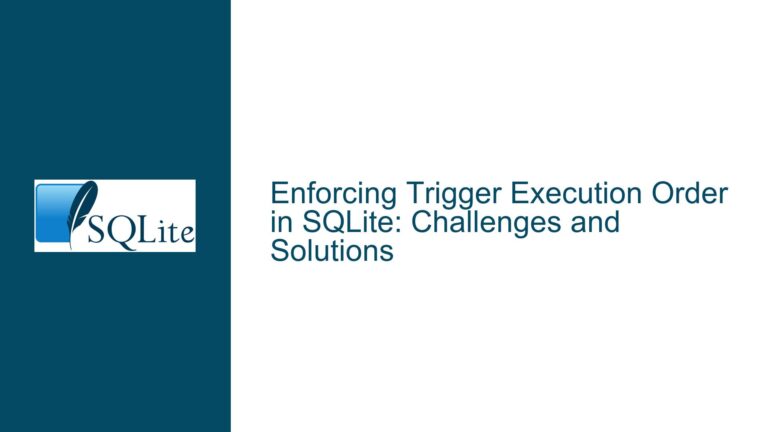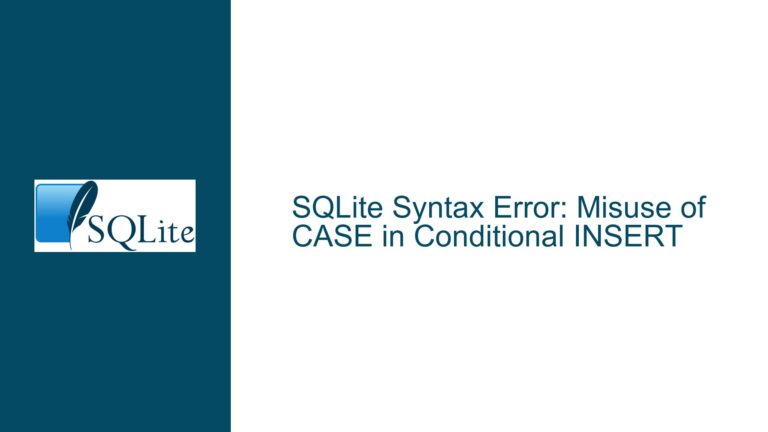SQLite WHERE Clause Evaluation Order and JSON_PATCH Ambiguity
Issue Overview: Ambiguous WHERE Clause Evaluation Leading to Unexpected Results
The core issue revolves around the behavior of SQLite’s WHERE clause evaluation order, particularly when dealing with functions like json_patch and conditional expressions involving AND/OR operators. In the provided scenario, a query involving two tables, t0 and t1, with a json_patch function call in the WHERE clause, produces unexpected results. The query is structured as follows:
CREATE TABLE IF NOT EXISTS t0 (c0 INTEGER);
CREATE TABLE IF NOT EXISTS t1 (c0 INTEGER);
CREATE INDEX i29 ON t1(c0);
INSERT INTO t0 VALUES (x'');
INSERT INTO t1 VALUES (0x47d9a1ab);
INSERT INTO t0 VALUES (0.8874540680509563);
INSERT INTO t0 VALUES (NULL);
INSERT INTO t0 VALUES ('-2017888786');
SELECT ALL t0.c0 FROM t0, t1 WHERE (0 OR json_patch(t0.c0, t1.c0)) AND (((t1.c0) BETWEEN (t0.c0) AND (t1.c0)));
The query is expected to return specific rows from t0 based on the conditions specified in the WHERE clause. However, the results are inconsistent with expectations, and the json_patch function appears to behave ambiguously. The root cause lies in the evaluation order of the WHERE clause terms and the behavior of the json_patch function when encountering invalid JSON inputs.
The json_patch function is designed to merge two JSON documents. However, if either of its arguments is not valid JSON, it raises a runtime error. In this case, the first row of t0 contains a zero-length blob (x''), which is not valid JSON. This raises the question: why does the query not fail when json_patch is called with this invalid input? The answer lies in the evaluation order of the WHERE clause terms and the fact that SQLite does not guarantee a specific evaluation order for these terms.
Possible Causes: Evaluation Order Ambiguity and JSON_PATCH Behavior
The primary cause of the issue is the ambiguity in the evaluation order of the WHERE clause terms in SQLite. SQLite does not guarantee a specific order in which the terms of a WHERE clause are evaluated. This means that the database engine is free to evaluate the terms in any order it deems optimal, which can lead to different outcomes depending on the evaluation path taken.
In the provided query, the WHERE clause contains two main conditions connected by an AND operator:
(0 OR json_patch(t0.c0, t1.c0))(((t1.c0) BETWEEN (t0.c0) AND (t1.c0)))
The first condition involves the json_patch function, which can raise a runtime error if its arguments are not valid JSON. The second condition is a BETWEEN clause that filters rows based on the values in t0 and t1. The ambiguity arises because SQLite may choose to evaluate the BETWEEN clause first, which could prevent the json_patch function from being called with invalid inputs. However, if SQLite chooses to evaluate the json_patch function first, the query would fail due to the invalid JSON input.
Another contributing factor is the behavior of the json_patch function itself. When json_patch is called with invalid JSON inputs, it raises a runtime error. However, if the function is never called with invalid inputs due to the evaluation order of the WHERE clause terms, the query will not fail. This leads to the observed behavior where the query returns results without raising an error, even though it contains a potentially problematic json_patch call.
The lack of short-circuit evaluation guarantees in SQLite further complicates the issue. In many programming languages, such as C/C++, logical operators like AND and OR are evaluated in a short-circuit manner, meaning that if the result of the expression can be determined by evaluating only the first operand, the second operand is not evaluated. However, SQLite does not guarantee short-circuit evaluation for WHERE clause terms. This means that even if the first condition in an AND expression is false, SQLite may still evaluate the second condition, leading to potential runtime errors or unexpected results.
Troubleshooting Steps, Solutions & Fixes: Ensuring Predictable Query Behavior
To address the issue of ambiguous WHERE clause evaluation and ensure predictable query behavior, several steps can be taken:
Explicitly Validate Inputs Before Using JSON Functions: Before using functions like
json_patch, explicitly validate the inputs to ensure they are valid JSON. This can be done using thejson_validfunction, which returns 1 if the input is valid JSON and 0 otherwise. By adding a validation step, you can prevent runtime errors caused by invalid JSON inputs.SELECT ALL t0.c0 FROM t0, t1 WHERE (json_valid(t0.c0) AND json_valid(t1.c0) AND (0 OR json_patch(t0.c0, t1.c0))) AND (((t1.c0) BETWEEN (t0.c0) AND (t1.c0)));In this modified query, the
json_validfunction is used to ensure that botht0.c0andt1.c0are valid JSON before callingjson_patch. This prevents the function from being called with invalid inputs, eliminating the possibility of runtime errors.Use Subqueries or Common Table Expressions (CTEs) to Isolate Conditions: Another approach is to use subqueries or CTEs to isolate conditions that depend on the results of other conditions. By breaking down the query into smaller, more manageable parts, you can control the evaluation order and ensure that potentially problematic conditions are only evaluated when their inputs are valid.
WITH valid_json AS ( SELECT t0.c0 AS c0_t0, t1.c0 AS c0_t1 FROM t0, t1 WHERE json_valid(t0.c0) AND json_valid(t1.c0) ) SELECT c0_t0 FROM valid_json WHERE (0 OR json_patch(c0_t0, c0_t1)) AND (((c0_t1) BETWEEN (c0_t0) AND (c0_t1)));In this example, a CTE named
valid_jsonis used to filter out rows wheret0.c0ort1.c0are not valid JSON. The main query then operates on the filtered results, ensuring thatjson_patchis only called with valid inputs.Avoid Ambiguous WHERE Clause Structures: To minimize the risk of ambiguous evaluation orders, avoid complex WHERE clause structures that rely on the evaluation order of terms. Instead, break down the conditions into separate queries or use explicit joins to control the flow of data.
SELECT t0.c0 FROM t0 JOIN t1 ON t1.c0 BETWEEN t0.c0 AND t1.c0 WHERE json_valid(t0.c0) AND json_valid(t1.c0) AND (0 OR json_patch(t0.c0, t1.c0));In this query, the
JOINclause is used to explicitly define the relationship betweent0andt1, and thejson_validfunction is used to ensure that only valid JSON inputs are processed. This approach reduces the ambiguity in the evaluation order and ensures more predictable query behavior.Understand and Leverage SQLite’s Evaluation Behavior: While SQLite does not guarantee a specific evaluation order for WHERE clause terms, understanding its behavior can help you write more robust queries. For example, SQLite may choose to evaluate simpler or more selective conditions first to optimize query performance. By structuring your queries to take advantage of this behavior, you can reduce the likelihood of encountering issues related to evaluation order.
Consider Alternative Database Designs: In some cases, the issue may stem from the database design itself. For example, storing JSON data in a column that is not explicitly typed as JSON can lead to inconsistencies and errors. Consider using a more appropriate data type or schema design to ensure that the data is stored and processed correctly.
CREATE TABLE IF NOT EXISTS t0 (c0 JSON); CREATE TABLE IF NOT EXISTS t1 (c0 JSON);By defining the columns as
JSONtype, you can enforce stricter validation and ensure that only valid JSON data is stored in the tables. This reduces the risk of runtime errors when using JSON functions likejson_patch.Monitor and Test Query Behavior: Finally, it is important to thoroughly test and monitor the behavior of your queries, especially when dealing with complex conditions and functions. Use tools like
EXPLAIN QUERY PLANto analyze how SQLite is evaluating your queries and identify potential issues related to evaluation order.EXPLAIN QUERY PLAN SELECT ALL t0.c0 FROM t0, t1 WHERE (0 OR json_patch(t0.c0, t1.c0)) AND (((t1.c0) BETWEEN (t0.c0) AND (t1.c0)));By analyzing the query plan, you can gain insights into how SQLite is processing your query and make adjustments as needed to ensure predictable and efficient execution.
In conclusion, the issue of ambiguous WHERE clause evaluation in SQLite can lead to unexpected query results, particularly when using functions like json_patch that are sensitive to input validity. By understanding the behavior of SQLite’s evaluation order, validating inputs, and structuring queries to minimize ambiguity, you can ensure more predictable and reliable query execution. Additionally, leveraging tools like EXPLAIN QUERY PLAN and considering alternative database designs can further enhance the robustness of your SQLite-based applications.
